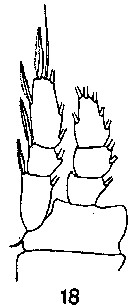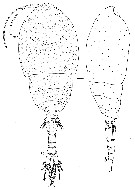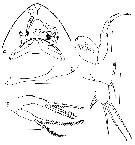|
|
 |
Fiche d'espèce de Copépode |
|
|
Siphonostomatoida ( Ordre ) |
|
|
|
Rataniidae ( Famille ) |
|
|
|
Ratania ( Genre ) |
|
|
| |
Ratania atlantica Farran, 1926 (F,M) | |
| | | | | | | Ref.: | | | Farran, 1926 (p.296, Descr.F, figs.F); 1929 (p.210, 283); Rose, 1933 a (p.285, figs.F); Vervoort, 1957 (p.146, Rem.); De Decker & Mombeck, 1964 (p.13,18); Owre & Foyo, 1967 (p.108, figs.F); Heron & Damkaer, 1969 (p.18, Descr.F,M, figs.F,M); Boxshall, 1979 (p.240, figs.F,M, Rem.); Boxshall & Halsey, 2004 (p.815, p.816: fig.F); Vives & Shmeleva, 2010 (p.408, figs.F,M, Rem.) |  issued from : G.P. Farran in Biscayan Plankton collected during a Cruise of H.M.S. 'Research', 1900.- Part XIV. The Copepoda. (Linn. Journ. Zoology, XXXVI, 1926). [p.305, Pl.10, Figs.11-12]. Female: 11, habitus (dorsal); 12, A1. Nota: Caudal rami slightly longer, being about twice as long as wide. A1 7-segmented; 7th segment equals combined length of segments 4-6 (and is proportionately longer than in R. flava)
|
 issued from : G.P. Farran in Biscayan Plankton collected during a Cruise of H.M.S. 'Research', 1900.- Part XIV. The Copepoda. (Linn. Journ. Zoology, XXXVI, 1926). [p.304, Pl.9, Fig.18]. Female: 18, P1.
|
 issued from : G.A. Heron & D.M. Damkaer in Smiths. Contr. Zool., 1969, 20. [p.19, Fig.22]. Female (NE Pacific): a-b, habitus (dorsal and lateral, respectively). Scale single bar: 0.100 mm. Nota : Rostrum a ridge produced ventrally from tergum of cephalosome. Dorsal surface of prosome and urosome bear scattered refractile points ; minute spinules densely cover most body surfaces, giving appearance of coarse-grained texture. Urosome 5-segmented. Genital segment slightly longer than combined length of 2 postgenital segments. Caudal rami slightly more than twice as long as wide, almost twice the length of anal segment. Anal segment and caudal rami with row of spinules on ventral posterior borders. P6 probably represented by ridge on anterior margin of opening oviduct, bearing 2 small spines.
|
 issued from : G.A. Heron & D.M. Damkaer in Smiths. Contr. Zool., 1969, 20. [p.20, Fig.23]. Female: A1. Scale single bar: 0.100 mm. Nota : A1 7-segmented. Armature : segment I with 7 elements ; II with 2 elements + 1 aesthete + 1 spine ; III with 1 e + 1 spine ; IV with 2 e + 1 spine ; V with 2 e ; VI with 1 e + 1spine ; VII with 11 e + 2 aesthetes. Terminal segment with 2 setae arising from same base ; 2 aesthetes on this segment each about twice the length of the antennula, the proximal aesthete with a thickening of the anterior margin
|
 issued from : G.A. Heron & D.M. Damkaer in Smiths. Contr. Zool., 1969, 20. [p.20, Fig.24]. Female: a, oral area (ventral); b, Md; c, Mx1; d, Mx2; e, P5. Scale bar: 0.100 mm. Nota : A2 similar to Giesbrecht’s (1892, Taf.48, fig.40) illustration for R. flava, except stronger terminal seta than in R. flava. Labrum slightly produced from oral area ; cone shaped, with distal row of short setules. Md with long, narrow, stalklike neck ; appendage terminates in a tip with 5 serrations and apical indentation setting off 3 more serrations, all of which are irregular. Mx1 differs from that of R. flava in proportional lengths of 3 spinulose setae of coxa and in having clusters of setules on outer margin. Palp with 3 long spinulose setae and 1 small nude seta. Mx2 2-segmented ; basal segment with cluster of setules on inner surface. 2nd segment with 2 indistinct lines of fusion ; 1 at midlength, accentuated by a small spine and a few setules, and 1 distally. Distal half of segment produced as slightly curving claw, with scattered setules ; Mxp as shown by Giesbrecht (1892, Taf.48, fig.43) for R. flava. P5 with flat free segment armed with finely barbed setae ; the lengths of the 2 short medial setae and 3 longer lateral setae varied between specimens. A finely barbed seta arises from body near insertion of free segment.
|
 issued from : G.A. Heron & D.M. Damkaer in Smiths. Contr. Zool., 1969, 20. [p.21, Fig.25]. Male: a-b, habitus (lateral and dorsal, respectively). Scale bar: 0.100 mm. Nota : Rostral area similar to that of female. Refractile points scattered over prosome and urosome (as in female) and most body surfaces, appendages, and mouthparts densely covered with minute setules more conspicuous than on female. Urosome 6-segmented
. Genital segment slightly wider than long. A2, labrum, Md, Mx1, Mx2 and Mxp resemble those of female. P1 to P5 as in female. P6 ventrolateral on genital segment, armed with 1 seta.
|
 issued from : G.A. Heron & D.M. Damkaer in Smiths. Contr. Zool., 1969, 20. [p.21, Fig.26]. Male: A1. Scale bar: 0.100 mm. Nota : A1 9-segmented, non clasping. Armature : segment I with 4 elements + 3 aesthetes ; II with 3 e + 1 spine ; III with1 e + 1 spine ; IV with 2 e + 1 spine ; V with 1 e ; VI with 1 e ; VII with 1 e + 1 spine ; VIII with 2 e + 1 aesthete ; IX with 8 e + 1 aesthete. Segments V-VI and VIII-IX correspond to segments V and VII in female. Dimorphism in male A1 further expressed on segment I, where 3 aesthetes replace 3 setae of female, and on segment II, where a long seta arises from site of aesthete on female.
| | | | | Ref. compl.: | | | Sewell, 1948 (p.506, 515); De Decker & Mombeck, 1964 (p.13); Deevey & Brooks, 1977 (p.156, tab.2, Station "S");Hopkins & Torres, 1988 (tab.1); Voronina & Kolosova, 1999 (p.72); Razouls & al., 2000 (p.343, Appendix); Galbraith, 2009 (pers. comm.) | | | | NZ: | 7 | | |
|
Carte de distribution de Ratania atlantica par zones géographiques
|
| | | | | | | | | | | | | Loc: | | | Antarct. (Weddell Sea, Indian, SW Pacif.), South Africa (E), off Bermuda (Station "S"), Sargasso Sea, Bay of Biscay, W Ireland, Medit. (Algiers), G. of Alaska, off British Columbia | | | | N: | 13 | | | | Lg.: | | | (25) F: 2,7-2,1; M: 2,79; (35) F: 2,75; 2,5; (38) F: 2,34; (138) F: 2,8-2,21; M: 2,62-2,42; (676) F: 2,63-2,21; M: 2,62-2,43; {F: 2,10-2,80; M: 2,42-2,79} | | | | Rem.: | bathypélagique.
Sampling depth (Antarct.) : 600-900 m.
Caractéristiques morphologiques female: A1 avec 7 segments. Longueur du prosome presque le double de celle de l'urosome.
Caractéristiques morphologiques mâle: A1 avec 9 segments. | | | Dernière mise à jour : 03/12/2020 | |
|
|
 Toute utilisation de ce site pour une publication sera mentionnée avec la référence suivante : Toute utilisation de ce site pour une publication sera mentionnée avec la référence suivante :
Razouls C., Desreumaux N., Kouwenberg J. et de Bovée F., 2005-2025. - Biodiversité des Copépodes planctoniques marins (morphologie, répartition géographique et données biologiques). Sorbonne Université, CNRS. Disponible sur http://copepodes.obs-banyuls.fr [Accédé le 04 décembre 2025] © copyright 2005-2025 Sorbonne Université, CNRS
|
|
 |
 |










